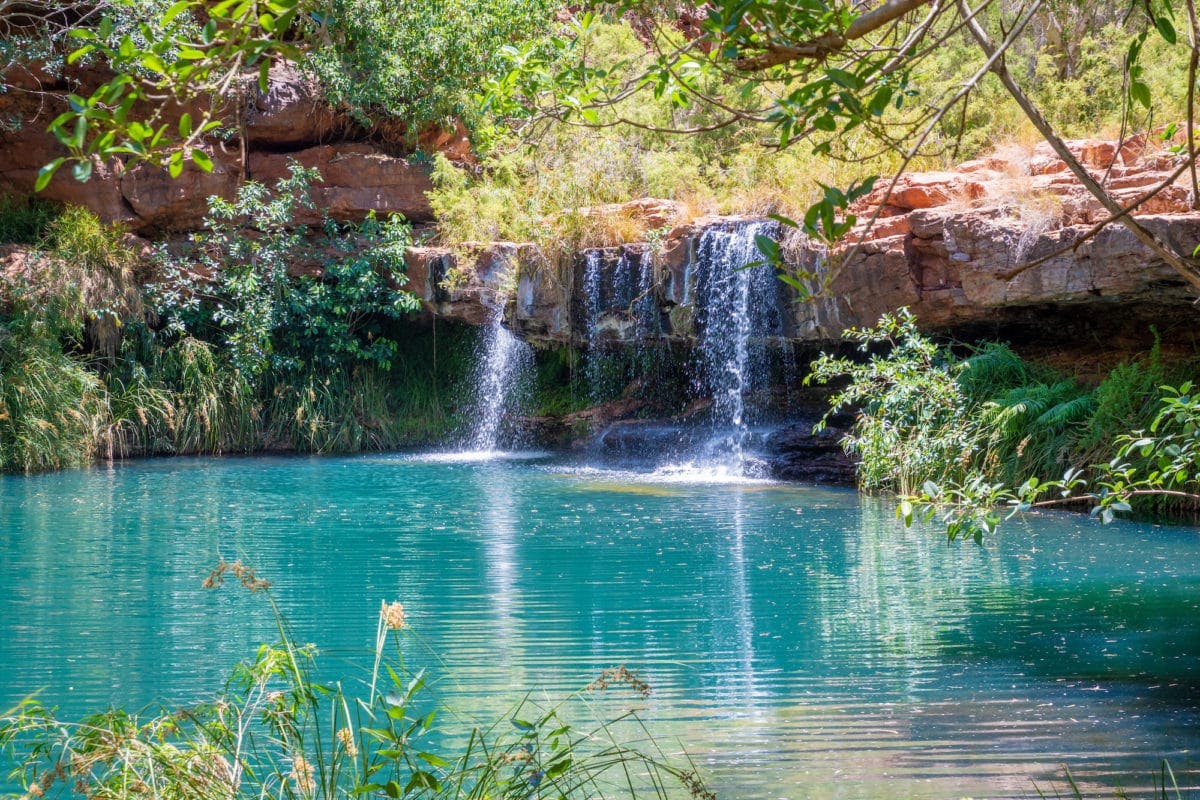Fern Pool, Karijini: Everything you need to know

The Pilbara is not only home to some of WA’s most stunning landscapes, but the world’s.
Ancient, iron-red gorges are contrasted by wide open skies and striking, turquoise watering holes. And one of the most magical of these is Fern Pool – a lush oasis amongst desert, it’s an idyllic spot for a refreshing swim, and is also a sacred place for the Banjima people.
What is it?
Also known as Jubara, Fern Pool is a picturesque swimming hole fed by a natural spring. Surrounded by lush ferns, there’s no mystery as to how the Pool got its name. The area’s spectacular gorges were formed a whopping 2.5 million years ago, as layers and layers of sediments on the ocean floor were put under extreme pressure, eventually turning into rock. As ocean levels dropped, rivers cut their way through, creating the dramatic chasms we can see today.
For the Banjima people, Fern Pool specifically holds significance as a women’s place, and where the Creator Serpent lived after winding through the land and creating the rivers and gorges of the Pilbara.
Where is it?
Fern Pool is located within Karijini – WA’s second largest national park, its spectacularly rugged landscape is home to ancient gorges, a glorious wildflower season and secret swimming holes. Part of the Pilbara’s Hamersley Ranges, Karijini encompasses three groups of Traditional Owners, with Fern Pool (at the west end of Dales Gorge) located on Banjima country.
To get to Karijini from Perth, it’s a 15 hour drive up the Great Northern Highway, or you can take a flight to Newman or Paraburdoo and drive the remainder (just over two hours from Newman and a little over one hour from Paraburdoo). As a national park, standard entry is $15 per car, or $8 concession.
Once you’re at Karijini, you’ll want to head to the Fortescue Falls Car Park – it’s only a 300m hike upstream along the gorge floor from the car park to the Pool, but it is rated as a Class 4 (which is recommended for more experienced bush walkers). While Karijini is theoretically 2WD accessible, many of the roads are gravel and only graded twice a year – so 4WDs are recommended.

What to do?
As a place of huge significance for the Banjima people, it’s important to treat Fern Pool with reverence – you’re welcome to swim and enjoy the water, but don’t jump, splash or make heaps of noise. Enjoy it as an opportunity for relaxation and reflection, instead! You can also relax knowing that there’s no crocs at Karijini, although you will get a pedicure from the tiny, nibbly fish!
Bring a friend! This is some pretty remote and untamed landscape, so it’s always recommended that you travel with a companion and let someone know your travels plans. Be aware of your surroundings – if it starts raining, you should leave the gorge immediately to avoid any flash floods. Make sure to dress appropriately with sturdy shoes, and bring plenty of drinking water.
You can also visit the neighbouring Fortescue Falls while you’re in the area, Karijini’s only permanent waterfall and only minutes from the carpark. At the other end of the gorge, you’ll find Circular Pool: another amazing swimming hole, it’s a much tricker hike to get there, with steep, uneven ground, ladders and obstacles.
While you’re in Karijini, you can also enjoy some of the wildflowers on display during the cooler months – when you can expect to see an explosion of yellow with wattle and cassia, as well as spectacular purple mulla mulla and northern bluebells.
For accommodation, Dales Campground is the closest – the only other accommodation within the park is at Karijini Eco Retreat, where you can glamp in style.
Subscribe to our free newsletter!
What not to do:
As we’ve already said, don’t jump in! Not only is it disrespectful to the Traditional Owners, but there is also the risk of submerged objects. Water in any of the gorges can be deeper than you expect – as well as colder – which can come as a shock. If you’re used to swimming at the beach, fresh water is also much less buoyant, so make sure you take it easy, swim within your abilities, and keep an eye on the kids. Between April and September, there’s a real risk of hypothermia, so it’s recommended you swim during the middle of the day.
Don’t visit the gorges after sunset – it’s super dangerous and you can’t follow the trails in the dark. While 4G towers have been installed at the Eco Retreat, campgrounds and visitor’s centre, don’t count on having any reception and plan accordingly.
Don’t bring any alcohol or glass into any of the gorges.
As with all visits to our natural spaces, adhere to the Leave No Trace Principles: meaning don’t leave any rubbish out there, don’t pick wildflowers and try your best to look after the surrounding area. Make sure you also adhere to any fire restrictions or bans that might be in place.
Header image: Shutterstock